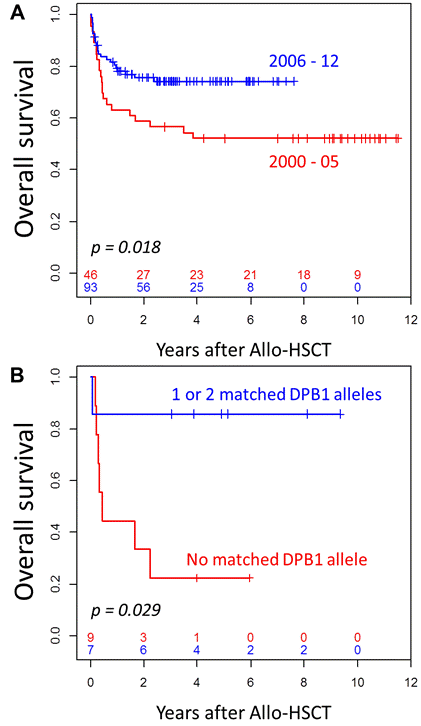Abstract
In the absence of a matched sibling donor for patients with severe aplastic anemia (SAA), allogeneic hematopoietic stem cell transplantation (Allo-HSCT) from an HLA-matched unrelated donor (UD) is considered after immune suppressive therapy (IST) failure. Outcome after UD Allo-HSCT for SAA has significantly improved in the last 2 decades because of optimization of HLA typing, as well as better conditioning regimens and improved GVHD prophylaxis (Maury Haematologica 2007; Bacigalupo Haematologica 2010). However, the age limit, the impact of extensive HLA typing (12 loci) as well as the best timing for UD Allo-HSCT remain unclear. We thus analyzed all patients in France who received a first Allo-HSCT for idiopathic SAA from a UD between 2000 and 2012. Clinical data were prospectively collected using ProMISe (Project Manager Internet Server), an internet-based data registry system shared by all centers of the French Society of Bone Marrow Transplantation and Cell Therapies (SFGM-TC). The French national ethics board (CCTIRS) approved this study. Written informed consent was obtained from all patients before Allo-HSCT.
One-hundred and thirty-nine consecutive patients (64 male (46%)) were included. Median age was 23 years (range: 1-66). Most patients (81%) received in vivo T-cell depletion using antithymocyte globulins or alemtuzumab. Total body irradiation was used in 64 patients (46%), using low dose in 58 cases (91%). GVHD prophylaxis combined Cyclosporine A and methotrexate in 68% of cases. Respectively 113 (81%) patients and 26 (19%) patients were transplanted using a 10/10 and a 9/10 HLA-matched UD (according to HLA A, B, C, DRB1 and DQB1 allelic matching). Ten patients (7%) experienced primary graft failure. Forty-eight patients developed grade II-IV acute GVHD, leading to a day-100 cumulative incidence of 35%. The cumulative incidence of chronic GVHD was 24% at 4 years (extensive GVHD, 8%) with no specific risk factor identified. With a median follow-up of 51 months, the 4-year overall survival (OS) was 66% for the whole cohort. In multivariate analyses, worst OS was observed for patients transplanted before 2006 (HR=2.45 [1.23-4.88]; p=0.011, Figure 1A), with a CD34+ cell dose < 4 x 106/kg (HR=2.62 [1.31-5.25]; p=0.006), with time from diagnosis to Allo-HSCT > 12 months (HR=2.16 [1.02-4.60]; p=0.046) and who received a 9/10 matched UD (HR=2.27 [1.05-4.91]; p=0.038). Of note, there was a trend for higher mortality in patients older than 40 years of age (HR=1.97 [0.95-4.09]; p=0.069). There was no difference in OS according to conditioning regimen or GVHD prophylaxis. Ninety-eight out of 139 patients had extensive HLA typing on 12 loci (HLA A, B, C, DRB1, DQB1 and DPB1), respectively 82 and 16 patients from the 10/10 and 9/10 HLA-matched groups. Zero, 1 and 2 DPB1 matched alleles were found in 36 (37%), 52 (53%) and 10 (10%) patients, respectively. Of note, we found no difference in 4-year OS according to DPB1 matching among the 82 evaluable 10/10 HLA-matched patients (0 (n=27) vs. 1 or 2 matched DPB1 alleles (n=55): 74% vs. 66%, p=0.466). However, patients transplanted with a 9/10 HLA-matched donor with no matched DPB1 allele reached a significantly lower 4-year OS (0 (n=9) vs. 1 or 2 matched DPB1 alleles (n=7): 22% vs. 86%, p = 0.029, Figure 1B).
In conclusion, outcome after UD Allo-HSCT for idiopathic SAA continues to improve with best results seen after 2005. In the presence of a 10/10 matched UD (allelic level), patients less than 40 years of age should be transplanted as quickly as possible if refractory to IST, at least in the first year after the time of diagnosis. Given the excellent OS in the recent period and the particularly low rate of chronic GVHD, Allo-HSCT could be discussed as front line therapy in selected young patients with SAA for whom a 10/10 UD is readily available in the absence of a matched family donor. Moreover, in the absence of a 10/10 HLA-matched UD, Allo-HSCT from a 9/10 HLA-matched UD in the presence of 1 or 2 matched DPB1 alleles is promising and merits further evaluation.
A) Overall survival in the 139 patients according to the transplantation period and B) according to DPB1 matching in the patients who received a 9/10 HLA-matched UD Allo-HSCT
A) Overall survival in the 139 patients according to the transplantation period and B) according to DPB1 matching in the patients who received a 9/10 HLA-matched UD Allo-HSCT
No relevant conflicts of interest to declare.
Author notes
Asterisk with author names denotes non-ASH members.


This feature is available to Subscribers Only
Sign In or Create an Account Close Modal